fort laramie

 My grand-nephew, Matthew Masterson is growing up so fast. According to his mom, Dustie Masterson, Matthew is a real man boy these days. He is very protective of his mom and his sisters. When his dad, my nephew, Rob Masterson had to go to South Carolina for training for work, it ended u being at the same time that Matthew was supposed to be staying in Fort Laramie, Wyoming with a friend of his. As Matthew thought about his mom and sisters at home without a man in the house, he just couldn’t stand it. And his mom secretly felt the same way. Matt called his mom and asked her to drive to Fort Laramie and pick him up. The visit with his friend would have to be another time. So right after she dropped Rob at the airport, she made the drive back up to pick him up. Matt stuck to his mom and sisters like glue, even going outside with his mom when she went out to smoke. When his dad is not home, Matt considers himself the family protector. He is learning to shoot and to be safe with guns, so he can keep his family safe.
My grand-nephew, Matthew Masterson is growing up so fast. According to his mom, Dustie Masterson, Matthew is a real man boy these days. He is very protective of his mom and his sisters. When his dad, my nephew, Rob Masterson had to go to South Carolina for training for work, it ended u being at the same time that Matthew was supposed to be staying in Fort Laramie, Wyoming with a friend of his. As Matthew thought about his mom and sisters at home without a man in the house, he just couldn’t stand it. And his mom secretly felt the same way. Matt called his mom and asked her to drive to Fort Laramie and pick him up. The visit with his friend would have to be another time. So right after she dropped Rob at the airport, she made the drive back up to pick him up. Matt stuck to his mom and sisters like glue, even going outside with his mom when she went out to smoke. When his dad is not home, Matt considers himself the family protector. He is learning to shoot and to be safe with guns, so he can keep his family safe.
Matt is turning 13, and going into 7th grade this year. It’s hard to believe he is getting so grown up. Matt is totally into online gaming with his friends from school. He really likes Tom Clancy’s Rainbow Siege 6 and Fortnight. Now, if only he can remember not to “team kill” and get banned for another week. I guess it’s easy to get carried away sometimes. Nevertheless, I’m sure that it won’t take him too long to become a master at both games. Gaming if great, but Matt likes to cook too, and when given the choice between cooking with his mom and gaming…well cooking is the only thing that Matt will immediately flip off the Xbox for.

 Matt’s family recently moved into a new home, and now he has his own room, which he really loves. One surprising thing came about with having his own room. Suddenly Matt is meticulous about keeping his room clean. Now that, for most boys is a amazing thing, of course, it all gets back to normal for boys when you hear that along with having his room clean, he also works very hard to keep it girl free!! I guess it’s one thing to be protective of his sisters, but totally another to share his space with them. Today is Matt’s birthday. Happy birthday Matt!! Have a great day!! We love you!!
Matt’s family recently moved into a new home, and now he has his own room, which he really loves. One surprising thing came about with having his own room. Suddenly Matt is meticulous about keeping his room clean. Now that, for most boys is a amazing thing, of course, it all gets back to normal for boys when you hear that along with having his room clean, he also works very hard to keep it girl free!! I guess it’s one thing to be protective of his sisters, but totally another to share his space with them. Today is Matt’s birthday. Happy birthday Matt!! Have a great day!! We love you!!
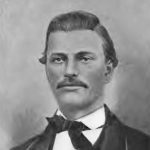 The move west to settle America was seldom a peaceful move. These days we think of loading up our car, and moving to a new city…done and easy, but it wasn’t so back then. There were outlaws, Indians, and unknown perils that could end a trip west, almost before it got started. There were a number of trails commonly used to get to the gold fields in the west, but the Bozeman Trail was one of the most violent, quarrelsome, and ultimately failed experiments in American frontier history. The trail was named for John Bozeman, an emigrant from Georgia, who was said to have blazed the route, but in actuality, the Indians had been using the route as a travel corridor for centuries. Nevertheless, John Bozeman did play a part in the trail. In 1863, Bozeman and partner, John Jacobs widened this corridor for use as a wagon road. They were following in much the same footsteps as Captain William Raynolds had four years earlier in a mapping and exploration expedition for the Army Corps of Topographic Engineers. The plan was to make the trail a shortcut to the goldfields in and around Virginia City, Montana territory. The Bozeman route split off of the Oregon Trail in central Wyoming. Then it skirted the Bighorn Mountains, crossed several rivers including the Bighorn, then traversed mountainous terrain into western Montana. The trail follows a very similar route to the current roads that meander through Wyoming today. The Bozeman trail had several advantages, including an abundant supply of water along with the most direct route to the goldfields, making it the go to trail of that era.
The move west to settle America was seldom a peaceful move. These days we think of loading up our car, and moving to a new city…done and easy, but it wasn’t so back then. There were outlaws, Indians, and unknown perils that could end a trip west, almost before it got started. There were a number of trails commonly used to get to the gold fields in the west, but the Bozeman Trail was one of the most violent, quarrelsome, and ultimately failed experiments in American frontier history. The trail was named for John Bozeman, an emigrant from Georgia, who was said to have blazed the route, but in actuality, the Indians had been using the route as a travel corridor for centuries. Nevertheless, John Bozeman did play a part in the trail. In 1863, Bozeman and partner, John Jacobs widened this corridor for use as a wagon road. They were following in much the same footsteps as Captain William Raynolds had four years earlier in a mapping and exploration expedition for the Army Corps of Topographic Engineers. The plan was to make the trail a shortcut to the goldfields in and around Virginia City, Montana territory. The Bozeman route split off of the Oregon Trail in central Wyoming. Then it skirted the Bighorn Mountains, crossed several rivers including the Bighorn, then traversed mountainous terrain into western Montana. The trail follows a very similar route to the current roads that meander through Wyoming today. The Bozeman trail had several advantages, including an abundant supply of water along with the most direct route to the goldfields, making it the go to trail of that era.
Still, the trail had one major drawback. It cut through the heart of territory that had been promised to several Indian tribes by the Treaty of Fort Laramie in 1848, making the people traveling the trail…the outlaws. The area included the rich hunting grounds of the Powder River Country, claimed by the Sioux and other tribes. They were not feeling very hospitable about these “white men” traipsing through their hunting grounds, killing their animals, and running off many in the herds. Nevertheless, the first emigrant trains began traveling up the trail not long after Bozeman and Jacobs had finished marking the route. In 1864, a large train of 2,000 settlers 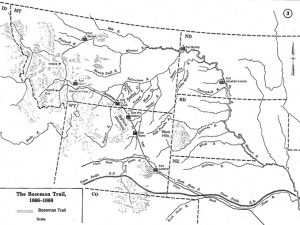 successfully made the trek. This was the high point of travel along the corridor. Though some wagon trains were successful after that, there were constant threats of attack. Over the next two years travel along the corridor came to a complete halt because of numerous raids by a coalition of tribes.
successfully made the trek. This was the high point of travel along the corridor. Though some wagon trains were successful after that, there were constant threats of attack. Over the next two years travel along the corridor came to a complete halt because of numerous raids by a coalition of tribes.
Then the people started to put pressure on the United States government to protect the travelers. In 1866, United States Army troops were dispatched to construct three forts along the trail, which would supposedly offer protection to wagon trains. These posts, running from south to north, were Forts Reno, Phil Kearny and C.F. Smith. Ominously, each of these forts was named after a general that had died during the just completed Civil War. Somehow that doesn’t seem to instill a lot of hope…at least to me. With the installation of the forts, the trail had, in effect become a military road. The protection afforded by the United States Army presence enraged the tribes. With that intervention came a two year conflict, known as Red Cloud’s War. Under the leadership of Oglala Lakota chief Red Cloud, raids and ambushes were carried out against soldiers, civilians, supply trains and anyone else who dared to attempt the trail.
Three famous skirmishes were The Fetterman Massacre, in December, 1866, in which an army detachment of 79 soldiers and 2 civilians led by Captain William Fetterman were lured from Fort Phil Kearney and ambushed within a few miles of the fort. On August 1, 1867, the Hayfield Fight, where 19 soldiers and 6 civilians detailed for guard and hay cutting duty were attacked. The Indians held them under siege for over 8 hours, but they managed to hold off 500 hundred warriors until help arrived. And finally, The Wagon Box Fight, where a detachment of 31 soldiers sent out to guard a team of wood cutters, was encircled. They fought off numerous attacks over a five hour period from hundreds of warriors. These continued raids and skirmishes were the rule that proved that peace was not going to be the reality they had hoped. Life guarding the trail was a 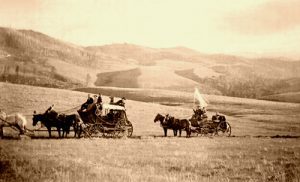 combination of tension, monotony, and loneliness. Soldiers on the verge of mutiny and even cases of insanity, deserted their posts. With few, if any, emigrants using the trail, because they were too afraid, the army sequestered behind fortress walls and tribes showing few signs of easing up on attacks. Finally, the United States government decided to pursue a peace policy. The second (1868) Fort Laramie Treaty recognized the Powder River Country once again as the hunting territory of the Lakota and their allies. A presidential proclamation was issued to abandon the forts. The Bozeman Trail was history, and for the first time, the United States government had lost a war. What a shock that must have been for our nation.
combination of tension, monotony, and loneliness. Soldiers on the verge of mutiny and even cases of insanity, deserted their posts. With few, if any, emigrants using the trail, because they were too afraid, the army sequestered behind fortress walls and tribes showing few signs of easing up on attacks. Finally, the United States government decided to pursue a peace policy. The second (1868) Fort Laramie Treaty recognized the Powder River Country once again as the hunting territory of the Lakota and their allies. A presidential proclamation was issued to abandon the forts. The Bozeman Trail was history, and for the first time, the United States government had lost a war. What a shock that must have been for our nation.
 My co-worker is a high school student named, Amanda Ingram. Amanda is also taking a college class through the Boces program this summer. She is taking Wyoming History, and she was required to write a paper concerning the boom and bust cycle in Wyoming, using newspapers from the 19th, 20th and 21st centuries. She was given a public website to use to locate news articles for her paper. That intrigued me, and I decided to check out the site. The site allows you to look by city, county, year, or simply by all newspapers. When I went in to look, I of course, went for the oldest newspaper they had.
My co-worker is a high school student named, Amanda Ingram. Amanda is also taking a college class through the Boces program this summer. She is taking Wyoming History, and she was required to write a paper concerning the boom and bust cycle in Wyoming, using newspapers from the 19th, 20th and 21st centuries. She was given a public website to use to locate news articles for her paper. That intrigued me, and I decided to check out the site. The site allows you to look by city, county, year, or simply by all newspapers. When I went in to look, I of course, went for the oldest newspaper they had.
What I found was so exciting. That first newspaper in Wyoming was The Chugg Water Journal, out of Fort Laramie, published on October 2, 1949. For those who live in Wyoming, spelling Chugwater…Chugg Water is very strange. That made me think, mostly about what Chugwater meant anyway, and why it might be written Chugg Water for the newspaper. The word “chug” is 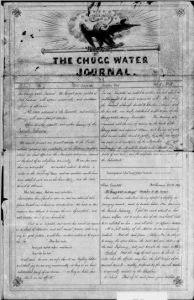 said to describe the noise that the buffalo or the falling chalk made when it hit the ground or fell into the water under the bluff, depending on which version of the legend you wish to believe. Because of that, the Indians began to call the area “water at the place where the buffalo chug.” The White Man adopted the Indian name and called the area “Chug Springs.” Chugwater Creek was named after Chug Springs, and from that came the name of Chugwater. Still, the reason for the name of the paper is speculation on my part. I am assuming that it was in an effort to remain more or less purist about the name, and since Chug Springs came first, that might be reason the paper was named the Chugg Water Journal.
said to describe the noise that the buffalo or the falling chalk made when it hit the ground or fell into the water under the bluff, depending on which version of the legend you wish to believe. Because of that, the Indians began to call the area “water at the place where the buffalo chug.” The White Man adopted the Indian name and called the area “Chug Springs.” Chugwater Creek was named after Chug Springs, and from that came the name of Chugwater. Still, the reason for the name of the paper is speculation on my part. I am assuming that it was in an effort to remain more or less purist about the name, and since Chug Springs came first, that might be reason the paper was named the Chugg Water Journal.
Aside from the name of the paper, I was very interested in the fact that it was hand written…at least at first. Of course, I knew that many newspapers were hand written at first, because there was no such thing as a printing press, or even typewriters for a long time, but to be able to actually view a handwritten newspaper was very exciting to me. My inquisitive mind embarked on a different thought journey. If the newspaper were hand written, and the 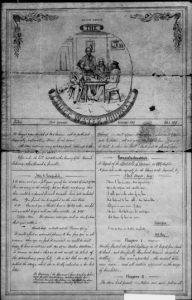 town had 50 families in it, all of whom wanted a paper, how long would it take to write all those papers up? And was it the same person doing it? Wow!! After a time, you would know the news by heart, and it would become seriously old news. Then, when you consider the fact that the paper was to “appear occasionally and sometimes oftener, if not sooner”…whatever that actually meant, the news became really old.
town had 50 families in it, all of whom wanted a paper, how long would it take to write all those papers up? And was it the same person doing it? Wow!! After a time, you would know the news by heart, and it would become seriously old news. Then, when you consider the fact that the paper was to “appear occasionally and sometimes oftener, if not sooner”…whatever that actually meant, the news became really old.
Still, the paper and its possible contents intrigued me. I started thinking about different dates and events in Wyoming’s history that might have appeared in that and other Wyoming newspapers. Would a first-hand account be more accurate that the history books? Even if history’s account is accurate, the newspapers would provide the feelings of the writer, and that is pure gold, because that makes it personal. I found myself feeling very excited about my future visits to this and other old and handwritten newspaper sites. I know that I will find many treasures.
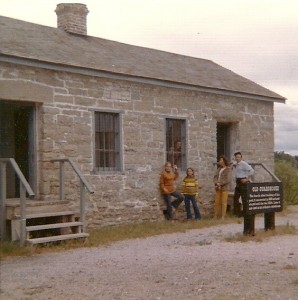 Many of the school children in Wyoming have had the unique opportunity to take a field trip to Fort Laramie, but most people didn’t go there as a family trip. My family, or I should say, my parents, liked a lot of things about the old west, especially any historical sites or trails. Over the years, we went to many of the sites around Wyoming and the surrounding states. Living in Casper, we have seen Fort Caspar, of course, but there have also been trips to Fort Laramie. One such trip, taken after I was married, and so not including my sister Cheryl or me…something that probably didn’t bother us then, but now, looking back, I’m sorry I didn’t get to go…mostly because Dad’s knowledge of the history of these places, and his love of teasing or role playing at these places always made things interesting. Dad would pretend to be one of the soldiers, or a trapper, or a shop keeper, so that he could pull us into the history of the place…hoping to pique our interest in the rich history of the area we live in. Most of the time, at least as we grew into our teens, his efforts failed to do much for us, other than maybe get a laugh if he was really acting funny, but as the years have gone by, I find myself very interested in the history of our great nation.
Many of the school children in Wyoming have had the unique opportunity to take a field trip to Fort Laramie, but most people didn’t go there as a family trip. My family, or I should say, my parents, liked a lot of things about the old west, especially any historical sites or trails. Over the years, we went to many of the sites around Wyoming and the surrounding states. Living in Casper, we have seen Fort Caspar, of course, but there have also been trips to Fort Laramie. One such trip, taken after I was married, and so not including my sister Cheryl or me…something that probably didn’t bother us then, but now, looking back, I’m sorry I didn’t get to go…mostly because Dad’s knowledge of the history of these places, and his love of teasing or role playing at these places always made things interesting. Dad would pretend to be one of the soldiers, or a trapper, or a shop keeper, so that he could pull us into the history of the place…hoping to pique our interest in the rich history of the area we live in. Most of the time, at least as we grew into our teens, his efforts failed to do much for us, other than maybe get a laugh if he was really acting funny, but as the years have gone by, I find myself very interested in the history of our great nation.
Fort Laramie, for example, was originally established as a private fur trading fort in 1834, but later evolved into the largest and best known military post on the Northern Plains, before it was abandoned in 1890. It was originally named Fort William after it’s founder William Sublette, and was purchased in 1841 by the American Fur Company and renamed Fort John. In 1949, it was purchased by the United States Army to protect the many wagon trains of migrant travelers on the Oregon Trail. At that time it was known as Fort John on the Laramie River, which later became Fort John-Laramie, and finally Fort Laramie. As a side note, the Laramie River was named after Jacques La Ramee. In 1815 or 1816, Jacques and a small group of fellow trappers settled in the area where Fort Laramie would later be located. He went out alone to trap in 1819 or 1820 and was never seen again. Arapaho Indians were subsequently accused of killing La Ramee and putting his body in a beaver dam. The river was named “Laramie” in his honor, and the name would later be given to the Laramie Mountains, the fort, and the towns of Laramie, Wyoming and Fort Laramie, Wyoming.
Today, I find all that history very interesting, but as a kid, history seemed like dry memorization of names and dates. Now I think I wouldn’t have minded living in those exciting times, or maybe just have the ability to travel back in time once in a while to see what The Old West was all about. I suppose I am a little too tech-minded to really have enjoyed that more primitive time for very long. Nevertheless, I guess my dad accomplished his goals with me. I do love the history of The Old West.

